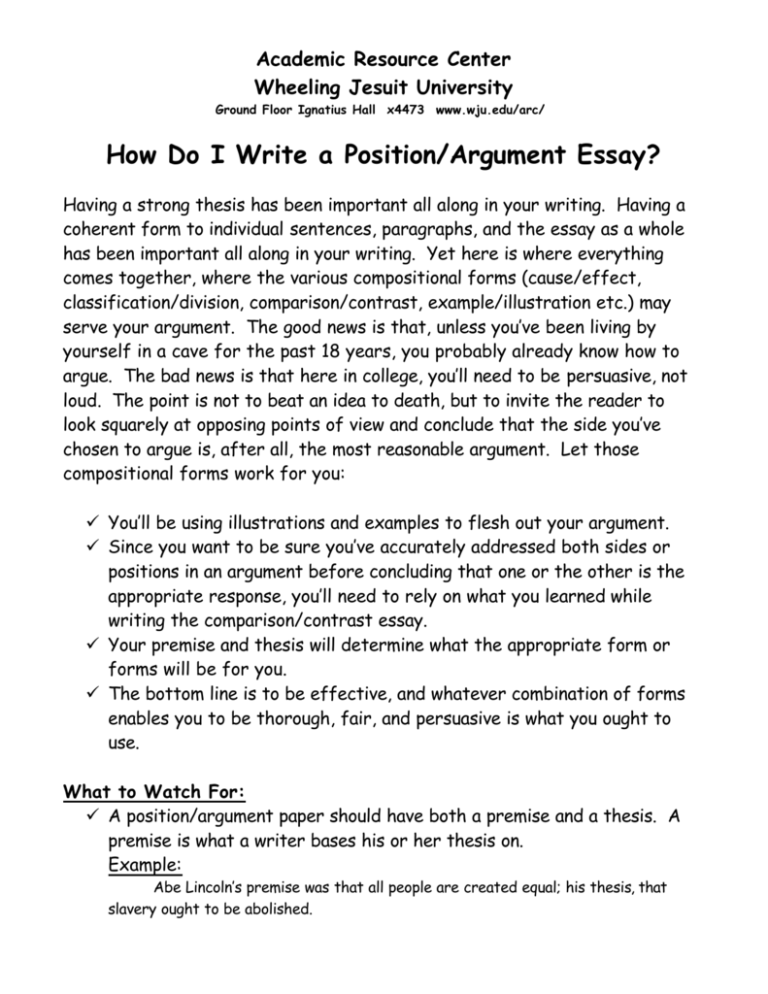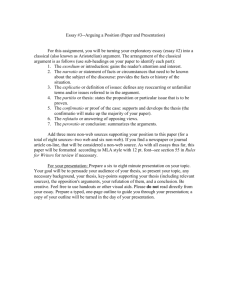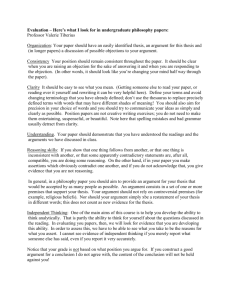How Do I Write a Position/Argument Essay?
advertisement

Academic Resource Center Wheeling Jesuit University Ground Floor Ignatius Hall x4473 www.wju.edu/arc/ How Do I Write a Position/Argument Essay? Having a strong thesis has been important all along in your writing. Having a coherent form to individual sentences, paragraphs, and the essay as a whole has been important all along in your writing. Yet here is where everything comes together, where the various compositional forms (cause/effect, classification/division, comparison/contrast, example/illustration etc.) may serve your argument. The good news is that, unless you’ve been living by yourself in a cave for the past 18 years, you probably already know how to argue. The bad news is that here in college, you’ll need to be persuasive, not loud. The point is not to beat an idea to death, but to invite the reader to look squarely at opposing points of view and conclude that the side you’ve chosen to argue is, after all, the most reasonable argument. Let those compositional forms work for you: ü You’ll be using illustrations and examples to flesh out your argument. ü Since you want to be sure you’ve accurately addressed both sides or positions in an argument before concluding that one or the other is the appropriate response, you’ll need to rely on what you learned while writing the comparison/contrast essay. ü Your premise and thesis will determine what the appropriate form or forms will be for you. ü The bottom line is to be effective, and whatever combination of forms enables you to be thorough, fair, and persuasive is what you ought to use. What to Watch For: ü A position/argument paper should have both a premise and a thesis. A premise is what a writer bases his or her thesis on. Example: Abe Lincoln’s premise was that all people are created equal; his thesis, that slavery ought to be abolished. ü Be very, very careful about holding up as self-evident a truth that is substantially (if not wholly) subjective. Example: The abortion issue comes to mind: one person’s fetus is another person’s human being. They’re both premises, but they’re both subjective premises (no matter what your religion says to the contrary) that must be argued reasonably before you can move onto your thesis. If your premise is based on the infamous three words, “Because it is,” you know it’s time to dig a bit deeper and explain why it is. ü Deductive and inductive lapses happen frequently. Example: How about the always fun “Real men don’t eat quiche. Cynthia doesn’t eat quiche. Therefore, Cynthia is a real man”? You may be so persuaded by your own belief system or point of view that you won’t suspect there are people out there, including professors, who do not tolerate logic fallacies. ü Be aware of audience, voice, and tone in the paper. Particularly if you’re arguing a controversial topic, there will be strong possibility of venturing into an area where emotions run high and logic gets trampled. Acknowledge the opposing argument and attempt to address what is most compelling and troublesome in that position. ü Don’t lapse into the first, or ESPECIALLLY, the second person: o First person may be acceptable if there is a useful anecdote you can offer from your own experience. o Second person implies that your reader has become either the target or the accomplice of the writer, neither of which ought to be the case. ü The tone should not become condescending, superior, or otherwise degrading to the reader or any opposition group. o Words like “obviously,” “of course,” “surely,” “without a doubt,” and so on, are almost always an indication either of the irrational or the unreasonable. o Be sure, in other words, of diplomacy: that you convince and do not offend. Structuring the Position/Argument Essay I. Introduction • Ought to include thesis and premise or premises on which the thesis is based. More than one paragraph is sometimes necessary. II. Body • May include justification for particularly subjective or otherwise controversial premises. • Always includes the sources of proof (including logic, facts, statistics, personal experience, anecdotes and/or testimonials, and research—if it happens to be a paper that allows or requires research). • Address both positions before concentrating on the side you’ve chosen, which may require adapting comparison/contrast form. III. Conclusion • Restates thesis and offers possible steps for correction or improvement of the paper’s problem or topic









